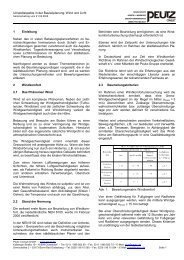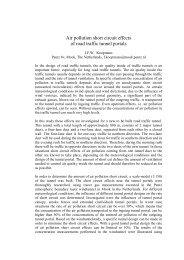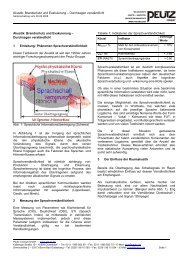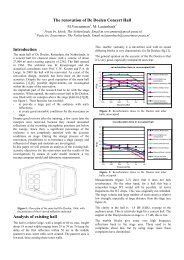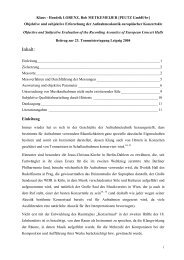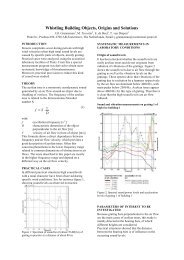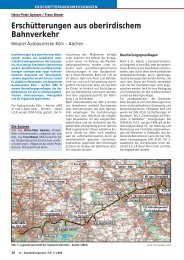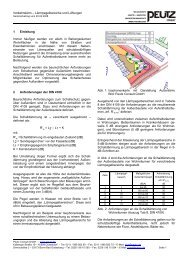Pipe noise - PEUTZ CONSULT GmbH
Pipe noise - PEUTZ CONSULT GmbH
Pipe noise - PEUTZ CONSULT GmbH
You also want an ePaper? Increase the reach of your titles
YUMPU automatically turns print PDFs into web optimized ePapers that Google loves.
PAGE 10<br />
separate plants are often based on ‘contour measurements’ around each plant, in<br />
accordance with ISO 8297 7 . In these situations, the application of inplant screening<br />
attenuation factors has proven to be very useful when the emitted sound of a certain<br />
plant is transmitted through adjacent open plant(s).<br />
Neglecting this excess attenuation can cause significant differences between<br />
calculated and measured sound levels in the surrounding areas, and as a<br />
consequence strongly influences the need and extent of sound reduction measures. If<br />
measurement of the reduction effect of inplant screening is not possible, the inplant<br />
screening factors, as mentioned in Table 2, can be useful.<br />
CONCLUSION<br />
In the design phase of an open plant, adequate <strong>noise</strong> control procedures such as<br />
ISO/FDIS 15664 are essential. Noise aspects of piping are important in open plants<br />
because of the vast number of pipe systems. When sound limits must be met at 1 m from<br />
pipe systems, valves, etc., the acoustic behaviour of the system should be foreseen in<br />
the design phase.<br />
Noise abatement at the source can significantly reduce sound emissions, and can<br />
sometimes lead to the elimination of the sound source. Implementation in existing<br />
situations is more expensive than the recognition of potential acoustic problems and<br />
determination of measures in the design phase.<br />
Given the contributions of specific parts of the pipe system, sound insulation must be<br />
executed with great care if it is to be effective.<br />
When <strong>noise</strong> limits must be met in the environment of an industrial plant, inplant screening<br />
must be considered because, due to this effect, the real emissions of an industrial plant<br />
might be lower than those calculated.<br />
REFERENCES<br />
1. ISO/FDIS 15664, Acoustics – Noise Control design procedures for open plant, 2001.<br />
2. ‘Geräusche bei Rohrleitungen; (‘Noise at pipes’)’, VDI Handbuch Lärmminderung<br />
3733, July 1996.<br />
3. ISO/FDIS 15665, Acoustics - Acoustic insulation for pipes, valves and flanges, 2003.<br />
4. Granneman J.H., Jansen R.P.M., ‘Sound power determination of large open plants;<br />
comparison of alternative methods’, Inter<strong>noise</strong> 99, December 1999.<br />
5. Granneman J.H., Beer E.H.A. de, Schermer F.A.G.M., ‘Inplant screening in<br />
petrochemical sites’, Inter<strong>noise</strong> 93, August 1993.<br />
6. ‘Guide for measuring and calculating industrial <strong>noise</strong>’, guideline issued by Dutch<br />
Ministry of Environment, April 1999.<br />
7. ISO 8297, Acoustics – Determination of sound power of multisource industrial plants<br />
for evaluation of sound pressure levels in the environment’, Engineering Method,<br />
1994.



